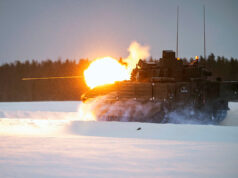BAE Systems is offering the Beowulf all-terrain vehicle for the U.S. Army’s Cold Weather All-Terrain Vehicle (CATV) programme.
According to a news release, the bid comes after Beowulf successfully completed the prototype evaluation phase of the program aimed at replacing the Army’s legacy fleet of vehicles for operating in tough arctic environments and other harsh terrains.
“Beowulf performed in multiple tasks while remaining fully mission capable during the prototype evaluation phase in Alaska that began in June and ended earlier this year. The testing included amphibious operations, navigating terrain with varying levels of complexity, starting and operating in extreme cold weather, and most critically, user assessment by soldiers. Ambient temperatures during the testing approached -50°F, and Beowulf performed in a region of Alaska that experienced one of the most severe winter storms on record.
Beowulf is an unarmored, tracked, and highly versatile vehicle for carrying personnel and payloads in either of its two compartments. Beowulf can traverse snow, ice, rock, sand, mud, and swamp conditions, and can operate in steep mountain environments. Its amphibious feature also allows it to swim in flooded areas or coastal waters.”
Mark Signorelli, vice president of business development at BAE Systems Platforms & Services, was quoted as saying:
“Beowulf was on point during the evaluation by demonstrating 100 percent availability, that it’s built for this mission and is an ideal solution for the CATV program. Beowulf’s design and capabilities are based on our decades of experience with all-terrain vehicles, and over millions of miles logged through our legacy vehicles currently engaged in operations in very challenging environments like the Arctic.”
Beowulf is built by BAE Systems Hägglunds in northern Sweden, adding firsthand experience in operating in an arctic environment. The platform includes several key components from U.S. suppliers, such as its engine, transmission, and hydraulic system.














Sounds impressive: any chance of their bidding for the Ajax replacement?
Any chance of starting from a clean sheet of paper?
Sunk cost fallacy.
Learned a lot by spending £5Bn…..
Indeed; as they say, if you are in a hole the first thing to do is stop digging.
BAES Hägglunds, yes, but not Beowulf. They would bid based on the CV90, another medium-weight armour tracked vehicle. Not just yet though. In order to cancel Ajax, crow must be swallowed, and that will take a little time.
My guess is Ajax will be replaced by
1a/ Ajax, a sticking plaster fix (the worst option)
1b/ Ajax, complete rework
2/ Lynx, Rheinmetall
3/ CV90, BAES Hägglunds
4/ Another bespoke, maybe tracked Boxer or a Lynx/Boxer hybrid
5/ Nothing, and all UK medium-weight armour will be wheeled.
Unfortunately I wouldn’t say lessons have to be learned first, as that’s a whole different ballgame. They may well screw it up again next time too.
Nice list. I was thinking about Lynx too: the Rheinmetal option looks looks politically more attractive than BAE’s CV90. The RBSL Ch3 partnership would be an attractive industrial option for both companies and the UK. Didn’t Lynx win the Australian Land 400 competition?
It’s a tracked vehicle and I’m sure those companies could get the CTA 40 mm on it if we wanted.
One version to replace Warrior and another filled with computers to replace Ajax?
I thought Boxer was replacing Warrior? So long as it has a stabilised cannon of course.
Yes; that is my understanding too. But what I am thinking is that Lynx is better suited to the IVF role and is tracked. Boxer is being considered as the Warrior replacement simply because its the only feasible contender right now. I am not an expert but take a step back and Lynx based replacements for Warrior and Scimitar look much more like what the army had in mind when they commissioned these projects.
Why would Rhinemetal option look more politically attractive then BAES CV90? Just interested in rationale behind buying a German solution rather than a UK/Swedish solution.
I would think that going with BAE CV90 now would be humiliating for the MOD. Lynx could be presented as a newer (German) design and if they were built by RBSL in the UK contributing to government industrial strategy; levelling up etc. Plus we might even get to fix both the WSCP and Ajax fiascos and maybe even use the paid for CTA 40mm cannons. Lynx could be a face saving option which works.
Jon,
Perhaps it should be said that your options 2-4 must be the recce variant, but it must also be capable of delivering ‘Strike’ as well.
I don’t understand option 5 – nothing – we replace a 50 year old Scimitar recce vehicle with nothing? and don’t do recce? or do recce using some other in-service vehicle? Like what? What do we use for Strike?
Always thought the recce lads would like something like a Ripsaw. Great for hooning around in. Sorry, I meant conducting stealthy reconnaissance.
All these battle Taxis like tanks and armed vehicles are simply metal coffins up against modern one man handled missiles . Maddness to be building tanks one A 10 would wipe out a column of tanks in no time .
Can you give an insight into how infantry can get close to the line of conflict, whilst being protected from the elements, shell splinters and small arms fire?
Helicopter.
Which is just as likely to get wiped out by enemy aircraft and manpads
As has been witnessed by how Russian helicopters fare in a MANPAD rich environment. Our I think would do slightly better, as they have been maintained and have better and more modern defensive aids. But would they be entirely invulnerable, I’m afraid not. There is a 50:50 chance against most systems built since 2000. If they have a direct infrared countermeasures (DIRCM) turret fitted. Then the chances fall back in the helicopter’s favour. But anything after 2015 with dual sensors like the latest Stinger, the chances drop even more. Something like Starstreak, it has a better than 95% chance against a helicopter even with the best countermeasures fitted.
Then there is also the cost. A Chinook costs north of £40 million, A Blackhawk about a 1/3 that price depending on specification. A fully equipped Bv206 is £250,000. But perhaps more importantly for places like Norway, is that it comes with a fully working heater!
Even more vulnerable, far fewer in service and to expensive, next please mate?
Its true. You need armoured vehicles to advance to contact and to hold ground. If Russian vehicles explosive reactive armour when fitted actually worked rather than being filled with sand or all Russian armoured vehicles had an active protection system … like Trophy for example Im not sure so many armoured vehicles would be metal coffins.
Its hard to draw any conclusions except. A canon armed ifv and its dismounted infantry will still take incoming MANPAD weapons but as long as the IFV can jam, decoy or destroy the incoming round its all good.
Spot on.
Not at all! Your comment is to simplistic and ignores the reality of the needs for Armoured Infantry and what they do!
Option 5 is we do it all wheeled, including Strike and Recce. Nothing tracked at the medium weight level. It all goes on Boxer.
France seems to have gone down this route, but I don’t know their kit well.
There are an awful lot of vehicles, both tracked and wheeled stuck in the Ukraine mud. The problem is we probably can’t afford sufficient for both .
One conflict might favour fast wheels over stony desert. The next might he snow on the northern flank.
OK, if Boxer recce variant (CRV) is good enough – could it do Strike as well? If not need Boxer CRV and Boxer Strike.
As we have discussed in another thread, there’s strike and there’s strike.
The French have Jaguar wheeled recce, with turretted CTA 40, and Griffon multi-role APCs. Both 6×6 and about the same max weight as Warrior.
Jon, I seem to remember that. I could not find a MoD definition of Strike in the modern era so had to invent my own. I really doubt if a 30-40mm cannon alone is much of a Strike weapon.
No great problem with wheeled recce (we had effective wheeled recce in the pre-CVR(T) era) – if you can more or less guarantee they won’t get bogged in and can cross reasonable width/depth ditches and streams.
I am still surprised at the insistence/trend that recce now needs a huge and heavy vehicle.
Wishful thinking, unfortunately the money isn’t there. If the army wants tracks we literally cannot afford Ajax to fail, the rest of the investment is going on boxer so unfortunately we are going to be wheels only
Jon, love the idea of a tracked Boxer. All modules to be available to the wheeled and tracked versions.
I picked up the idea from someone else on this forum. I wish I could remember who to give them the credit. I also like it, but I think we may have gone too far down the Ajax route.
I do trust BAE more so than a brand new subsidiary of the American General Dynamics company to build a decent military vehicle.
Agree. That said I think we need to accept our share of the blame for the way things have gone. Our strategy was flawed. It would be good to keep faith with GD by offering them some work; though I can’t think what at the moment. What Ajax and WSCP have done is to remind the MOD that a) BAE are competent engineers b) so are the Germans and c) European partnerships can work. BMW Minis, Neff ovens and Aldi are great value!
GD have Le TacCIS for all our vehicles!
Great! From HMG web site.
“Agile methodology; Evolutionary capability; Partnership; User Centred Design; Endorse and Espouse”
What could possibly go wrong…?
LOL.
And they’re screwing that up like they did Bowman…
If only we had stuck with Racal….their solution was far better than GD Bowman and they were British!
Graham, that’ll be the company that produces Abrams, LAV and Stryker?
Parent company produces those, but the UK subsidiary (GDUK) doesn’t. It seems incapable of bringing in parent company expertise in sufficent number and across all disciplines.
They also own Santa Barbera Sistema…in Spain, who have serious quality control issues…
I want one it would look the dogs dangles sitting on my drive, more than enough room to put the weekly shopping in.
Is that the Roswell alien driving it?
Ha! Good spot!
I have never really understood this bit; could someone please explain to me the pros and cons of articulated APCs like the Beowulf vs regular “mono-hull” APCs, why the former are preferred in snowy terrain, and why regular APCs like the Bulldog aren’t similarly articulated?
Two sets of articulated, driven tracks give much more available traction on poor surfaces. Bulldog is a 1960’s creature and doesn’t count nowadays. Poor ground clearance, weedy engine etc.
Total guess here but I suspect an articulated Vehicle like this would exert a good bit less load per given contact area on the surface when manoeuvring over rough or non flat terrain, probably important when you don’t know how firm those surfaces are in ice and snow.
Hi Spy, I’m by no means an expert either, but believe that it’s something to do with the method of steering. Most tracked vehicles use ‘skid/deferential’ steering, ie stop one track and keep the other moving turns said vehicle towards the stopped track.
Don’t fully understand articulated steering, but something to do with one unit being slewed in one direction while the other slewed the opposite way to allow said vehicle to turn!!!!
Someone please help as that’s a p**s poor explanation I know!
That’s more or less right. The original Bvs could also slow the inside tracks down, but this was found not to be necessary. Basically the tracks steer around the central pivot point between the cab and trailer. There are two hydraulic actuators either side of the pivot. These extend and retract depending on the steering input. By reducing the inside jack and extending the outer, the two halves change direction towards the smaller jack, i.e. they turn due to the reduced radius. You would think that this would feel awkward when making the turn, but it is actually quite smooth.
Glad I wasn’t totally with the fairies with my explanation.🤣 Does that mean that the Vikings always have the trailor connected? If not, assume the systems works on the cab unit alone?
Yep, it won’t work without the powered trailer. Though it can be a powered flat bed trailer. There have been some built for logistical supply, as they can carry about 5000kg. There have been some built as mortar carriers, battlefield radar surveillance, signals intelligence etc.
Its also not an OverSnow Vehicle!
The original BV series of vehicles that the Swedes required, was for a “battle taxi” that could operate throughout the year, but especially in the winter. Sweden has a lot of lakes and marshy terrain, but the weather during the very cold winters, puts an even greater pressure on vehicles.
Their requirement was for a amphibious vehicle that can cross lakes and marshy ground. But also carry troops over deep snow during the winter. To cross this type of terrain you need a really low ground pressure. Tracks will always give you a lower ground pressure than wheels due to the greater contact surface area. If you make a tracked vehicle too long though, it doesn’t want to turn. There’s a width to length ratio that is used for tracked vehicles, which I can’t find right now. But a great example is the TOG in Bovington tank museum. Awesome in straight lines and crossing trenches, crap for turning tight radiuses.
However, if you split the track length and put the pivot point in the centre of the two halves. You now have the mobility but also the necessary low ground pressure.
Good response, succinct and well “articulated”…….geddit?
Thank you. What’s the reason we don’t see articulated IFVs more commonly used?
Probably cost and simplicity. It is quicker and less expensive to make a single metal box, than two. It is also less complex, as you don’t need the pivot and actuator mechanism, two sets of drive train or four sets of tracks.
Isn’t it rather ‘old school’ for such a vehicle to be unarmoured? UK has had an armoured equivalent for many years. Perhaps it is not intended for use in combat zones?
The Beowulf is replacement for the Bv206. Which is just a battle taxi, i.e. get the troops near the frontline only. The Beowulf is an unarmoured version of the BvS10 Viking, which is armoured. I guess it depends on what the US Army wants, as the above article doesn’t list the specifications for the cold weather all terrain vehicle (CATV) programme. Otherwise I’m sure the Viking would have been offered. Though like the Bv206 it probably can have cage armour and ceramic plates fitted.
The Russians version a wheel barrow
Don’t knock the wheelbarrow.
They say you can go anywhere with a wheelbarrow as it always looks like you are working. Whether that would have applied to 50,000 Russians pushing barrows in Kiev, I’m not sure, but at least they’d have survived the attempt.
Depends if they had their Hi-Vis on as well as part of the ‘hidden in plain sight’ approach
The US Army is simply looking for a general-purpose cargo and troop transport for extremely cold weather. It only plans to procure 110 of these, so it’s a very small contract by Army standards. BAE will have a hard time beating Oshkosh Defense which has the other protype in the competition.
Oshkosh Defense’s offering is a licence built version of Bronco. I wouldn’t see it as a shoo-in at all, particularly as most of the US allies use Hagglunds kit and are likely to move to Beowulf as it has a lot of commonality with BvS10 Viking. Bronco has only sold to Singapore and Thailand. The UK retiring Bronco was hardly a vote of confidence long term, and despite being offered up at a bargain price there have been no takers…its the type of kit we should be sending to Ukraine..very useful on some of the ground there..
So anybody read the “British” Future soldier doc: )its a PDF)
https://www.army.mod.uk/media/15057/adr010310-futuresoldierguide_30nov.pdf
Very pretty document, pity the Army didn’t spend such time sorting out the mess they are in. Purchase kit that is affordable and does the job, even the basics like uniform is trashy and NOT MADE IN THE UK – try China – really!!!!!! God Help us. The Lads and lasses poorly led, Lions led by sheep
Made in China – lol – Have they worked out that the targets on their backs are not ‘MOD’ fashion (mod geddit) and are actually there for a more sinister ulterior motive….